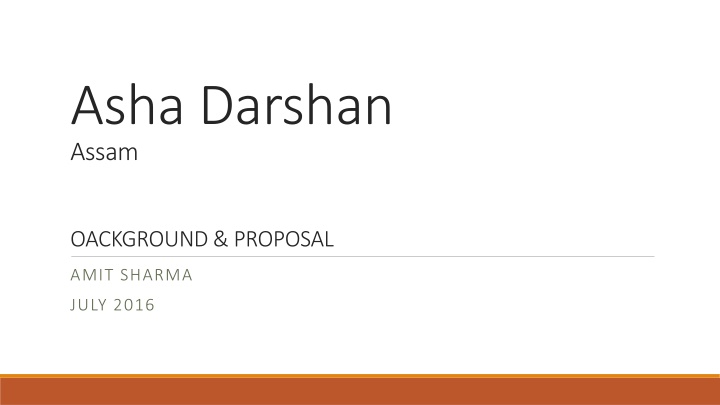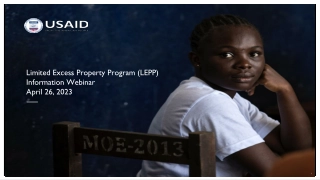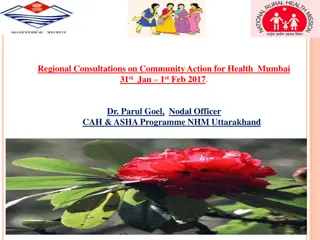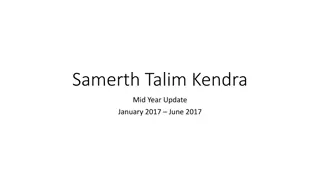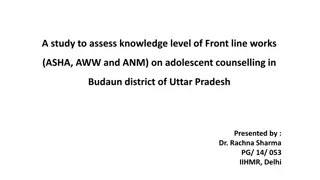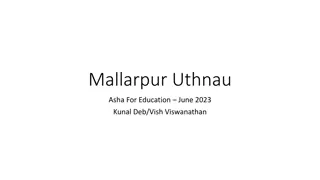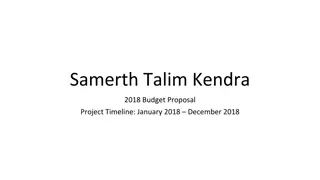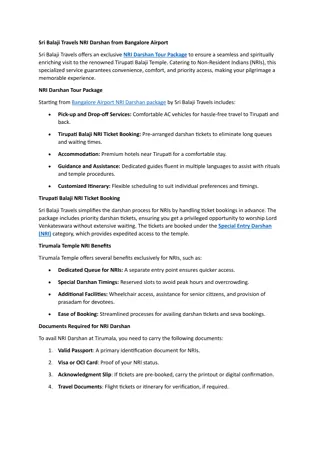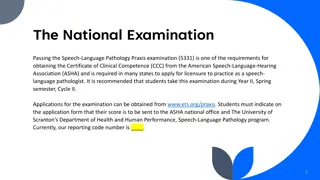Asha Darshan
Asha Darshan is a grassroots NGO in Assam, running education, women empowerment, community development, and environmental activism projects since 2000. It operates schools in Bodo tribal areas, providing education in Assamese and Bodo mediums. The region has faced historical conflicts and challenges, with limited access to education and healthcare. Asha Darshan has been instrumental in supporting schools, some of which have been adopted by the government. Their focus is on improving the lives of people in these areas.
Download Presentation

Please find below an Image/Link to download the presentation.
The content on the website is provided AS IS for your information and personal use only. It may not be sold, licensed, or shared on other websites without obtaining consent from the author.If you encounter any issues during the download, it is possible that the publisher has removed the file from their server.
You are allowed to download the files provided on this website for personal or commercial use, subject to the condition that they are used lawfully. All files are the property of their respective owners.
The content on the website is provided AS IS for your information and personal use only. It may not be sold, licensed, or shared on other websites without obtaining consent from the author.
E N D
Presentation Transcript
Asha Darshan Assam OACKGROUND & PROPOSAL AMIT SHARMA JULY 2016
Background Asha Darshan is one of the oldest AfE-SV projects, running since the year 2000 Asha Darshan Trust is the grassroots NGO and an AfE affiliate, similar to Asha Trust Biju Borbarua is the principal coordinator of Asha Darshan and has been working in the area since 1998 Asha Darshan s work is broadly organized into: Education Women Empowerment Community Development Environmental Activism
Overview Asha Darshan s education program spans 11 villages in Baksa and Tamalpur districts of Assam Education Program has expanded into Manipur with support from Stamford Primary site of Asha Darshan s is Bodo tribal area, governed by Bodo Tribal Council (BTC) Primarily agrarian society with large population dependent on small farming or seasonal labor The region has been historically marred by violent conflicts and militancy Political agreements and arrangements over the past decade have brought some normalcy to the region , however, there s little improvement in the lives of people Access to affordable and quality education and healthcare continues to be a challenge Relatively high [and rising] drug & substance abuse in the area
Education Program Asha Darshan runs schools with community support where there is a need and demand Since 2001 Asha Darshan has started 24 schools, of which 15 schools have been either converted (to) or adopted by the Government! Asha Darshan currently runs 9 schools Nagapur (Assamese medium) Nagapur (Bodo medium) Shimliguri Shantipur #1 Shantipur #2 Devinagar Satyanarayanpur Abhayapur Sonmuni
SL. No. Name of School Year of support Year of closing Govt. Support 1 Khumguri PP school 2000 2006 Anganwabi Kendra All 8 Pre-Primary schools have been supported as Aanganwaadi Centers by the Government 2 Bathouguri PP school 2000 2004 Do 3 Amlaiguri LP school 2000 2006 Govt. 4 Anthaibari PP school 2000 2011 Anganwadi Kendra 5 Jhargaon PP school 2000 2003 Do 7 LP Schools have been recognized by the Government as well 6 Nagapur PP school 2000 2007 Do 7 Kawli PP school 2000 2005 Do 8 Singramari LP school 2000 2010 Govt 9 Satyanarayanpur LP school 2000 Continue 10 Satyanarayanpur ME school 2006 Continue 11 Namati LP school 2000 2011 Govt. 12 Hajongbasti PP school 2000 2015 Govt 13 Lakhinarayanpur LP school 2000 2010 Do 14 Paharpur PP school 2004 2007 Do 15 2No. Shantipur LP school 2006 Continue 16 Danswarng LP school 2006 2010 Govt 17 Garughutu LP school 2006 2010 Govt. 18 Lakhinarayanpur ME school 2007 2015 Do 19 Nagapur ME School (Bodo)Medium 2007 Continue 20 Devinagar LP school 2007 Continue 21 Nagapur LP & ME school (Assamese) Medium 2008 Continue 22 Simliguri ME school 2009 Continue 23 Sunmuni LP school 2011 Continue 24 1No. shantipur LP school 2013 Continue
Education Program Government norms for setting up Aanganwaadi Centers is tribal density of 150-300, but, little or no support was available Asha Darshan started with opening per-primary schools in 7 hamlets in Tamalpur These centers were eventually upgraded to primary/upper-primaries as children graduated and little help came from the Government between 2007-2015 ICDS centers were either opened or pre-primary centers were adopted Nagapur is an exception where Asha Darshan ran a Secondary School to meet the damand and non availability of a school in 10-15km vicinity Adha Darshan schools are either Bodo or Assemese medium
Education Program Most schools are in temporary construction, with concrete floors but bamboo walls/roofs, and need annual (or frequent) repairs, especially during the rains Community generally works together on maintenance and repairs of the schools Schools are typically constructed on community [donated] land Schools follow the state curriculum, and free books were procured from the State Education Dept. Since 2010-11, only the schools with DICE Code were made mandatory for free supply of teaching and learning material, making Asha Darshan ineligible.
Education Program Multiple discussions with BEEO, SDO, and DC have been futile and Asha Darshan today either purchases the books and material from open market or by bribing the storekeepers of DICE book supply Official recognition of school typically requires a bribe of somewhere between Rs. 2.5L 3L Nagapur and Satyanaraynpur schools paid this bribe to get recognized and subsequently DICE codes
Education Program Field staff visits the schools 2/3 days every week and parents frequently visit and meet at the school SMC meetings are conducted every month, students, parents, and community at large attends the CMS meetings to discuss issues including, but not limited to, the school. Teacher meetings are held in rotation bases every month or two months There s a monthly meeting, last Sunday of every month, of teachers at Asha Darshan center in Bogajuli or Tamalpur Progress of all schools is discussed along with a post-training follow-up Annual teacher training program for all teachers Conducted with help from Asha Trust or other local NGOs with expertise in teacher training
Self Help Groups Asha Darshan runs an extensive network of SHGs since 1998 with a broad objective of empowering women socially and economically Initial target was the most backward poor working women with little savings because of non-linkage with banks Since 1998, 450 SHGs have become operational under Baksa and 24 under Dhemaji district Each SHG has between 10-15 members with nominal weekly contribution of Rs. 5-10 A SHG comprises of a president, vice president, secretary, an assistant secretary, and a treasurer. Group can take no or very low interest bearing loans on as-need basis SHGs have been targeted by the nationalized banks to meet their rural banking and grup banking targets Private lenders also target the SHGs for extending larger loans on unfavorable terms to members with the SHG pool as a collateral Asha Darshan is leveraging NRLM to rejuvenate SHGs and improving the overall economic condition of the women
Vocational Training Vocational Training program was started in 2002-3 for members of SHGs on the following areas: Candle making Tailoring Horticulture and improved farming practices Animal Husbandry Poultry Soft Toys and Tailoring The objective is to eventually ensure Rs. 10L by every SHG member
Mahila Shanti Sena Mahila Shanti Sena was formed in 2002 under the guidance of Paramshree Rabindra Nath Upadhyay with the following objectives: Rescue and counseling of victims of domestic abuse Raise awareness, rescue and rehabilitation of victims of human trafficking Health awareness amongst women and children Raise awareness about Right to Information and Right to Education Building a strong group of women leaders Raise awareness against militancy and violence Mahila Shanti Sena has played a critical role in formation of SHGs, and operations of the Asha Darshan schools. Women from Mahila Shanti Sena have played a critical role in reduction of violence in the region and promoting community participation in the region
Weavers Program Weaving Training & Production Handloom is traditional industry hat has been systematically decimated by introduction of modren power looms and import subsidies Weaving continues to be a potential means of economic empowerment with highly skilled labor pool Training Program using modified looms and Jakarta looms Focused on designing and quality of final product Started a local shop for direct sale with moderate success Over 200 weavers have received training from Asha Darshan Connecting Asha Darshan with Dasktar (Delhi) to participate in Nature Bazaar (Delhi) and get design and marketing training in 2016-17
Activities in 2015-16 International Women s Day celebration March 8th 16 in Tamalpur More than 300 women and girls participated Exposure visit of Asha darshan team March 12-15, 16 23 participants visited visited Apna Ghar (Tatyaganj, Kanpur) Apna Ghar is an Asha Trust project supported by AfE
Proposal for 2016-17 Budget http://www.ashanet.org/projects-new/documents/284/AD_budget_2016-17.docx (overall budget is 7879500 .00) Annual Report http://www.ashanet.org/projects-new/documents/284/Asha_Dharshan_Annual_Report-2016- 17.docx Site Visit Report http://www.ashanet.org/projects-new/documents/284/site_visit_2015.pdf
